
Growing succulents and cacti are usually easy because these plants don’t require much care. You can also grow them indoors, but this requires choosing plants that don’t need lots of light to survive and thrive. So, what are the best low-light succulents and cacti for indoors?
Some of the best low-light succulents and cacti for indoors include aloe, ponytail palm tree, echeveria, and gasteria. These offer a range of textures, colors, and shapes to add more visual interest to your home.
In this article, I’ll explore these and other succulents and cacti that don’t need lots of natural light and can be successfully grown even if you’re a beginner.
15 Low-Light Succulents and Cacti
Growing plants indoors can be challenging because you can’t always ensure that they’ll get enough light. This is especially true in winter, especially if your region experiences several weeks of icy cold and darkness. With this in mind, here are 15 of the best low-light cactus and succulent plants you can grow without a problem.
1. Aloe
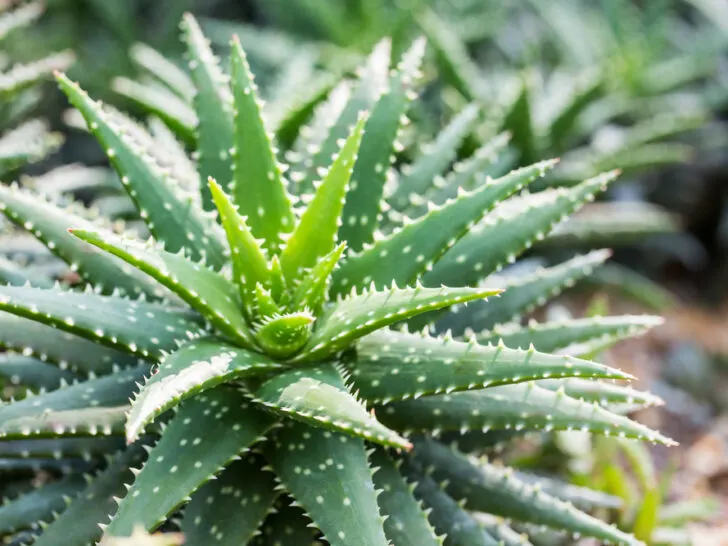
Aloe plants are easily recognized by their fleshy leaves, which can be green, gray, or blue. They perform well when kept in the sun or shade, which makes them excellent houseplants.
However, if you notice that your aloe is desperate for more light, such as if it’s stretching towards a window, you should aim to move it closer to the light source. Generally, aloe plants need six hours of sunlight per day.
2. Beaucarnea recurvata ‘Ponytail Palm Tree’
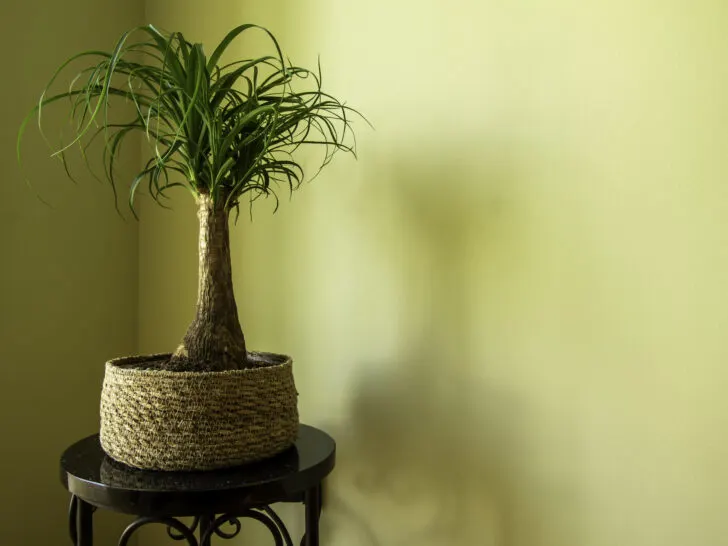
As its name suggests, the ‘Ponytail Palm’ has long, thin foliage that clumps, which makes it look like a ponytail. In nature, this desert plant has adapted to living in bright light, so it will perform well in a sunny window in the home. However, it can also survive in bright, indirect light.
You can even grow it in low-light areas, but make up for the lack of light by putting its pot outside during the summer so that it gets some sun to help it grow.
3. Echeverias

Originating from the mountainous regions of South and Central America, echeveria is the name given to a large group of tropical succulent plants that flower. Echeverias have rosette shapes and plump leaves and come in various colors.
Don’t keep echeveria plants in the harsh afternoon sun, as this will burn them. However, make sure your echeveria gets about four hours of bright, indirect light when kept indoors.
Signs that your echeveria isn’t getting enough light include:
- Legginess: Your succulent will become thinner and longer as it tries to stretch toward the light.
- Lack of flowering: If you don’t get a lot of sun at home, put your echeveria in the garden during the summer (its growing season) to boost its growth.
4. Gasteria ‘Little Warty’
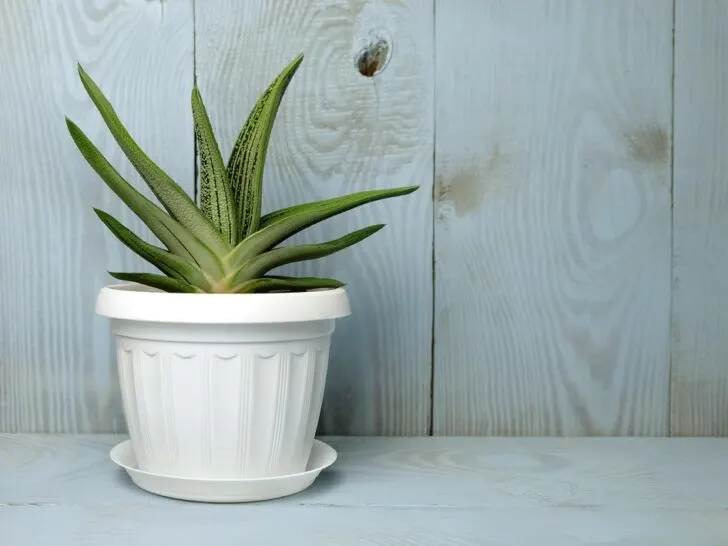
Gasteria is the name given to succulent perennials that don’t have stems and instead form clumps of fleshy leaves, although they do have tubular blooms. ‘Little Warty’ is a type of gasteria plant that doesn’t need a lot of light or water. This plant can tolerate full sun or partial shade with ease, which makes it easy to maintain.
It has beautiful speckled leaves that stack on top of each other as the plant grows. If you notice that your ‘Little Warty’ succulent is getting brown spots on its leaves, this is a sign it’s getting scorched by the light. You should move it away from the window or put it behind a curtain that will block out some of the harsh light.
5. Gasteraloe ‘Green Ice’
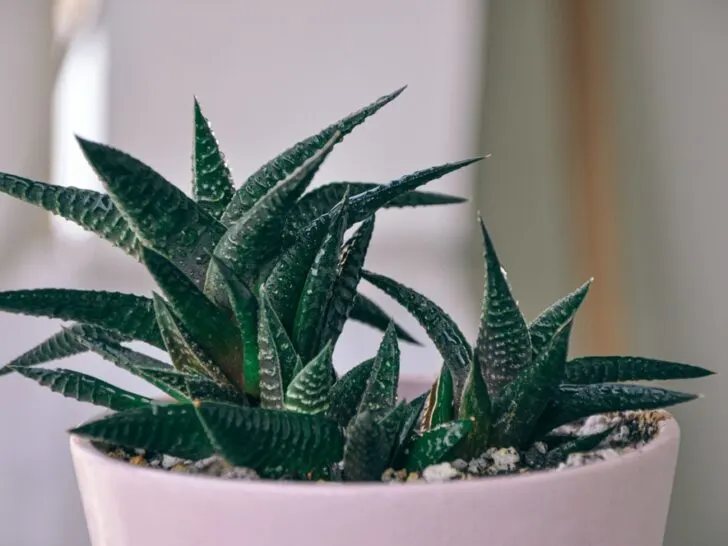
This slow-growing succulent with thick leaves marked with gray lines and spots is a hybrid between Gasteria ‘Little Warty’ and Aloe variegata.
‘Green Ice’ blooms in green and red flowers. It requires some bright, indirect light, but it’s not fussy, as it can tolerate lots of sunshine and partial-shade conditions without a problem.
If you’re going to keep it in a low-light room, such as a bathroom, be mindful of the humidity. This plant doesn’t want too much moisture.
6. Haworthia attenuata ‘Zebra Cactus’
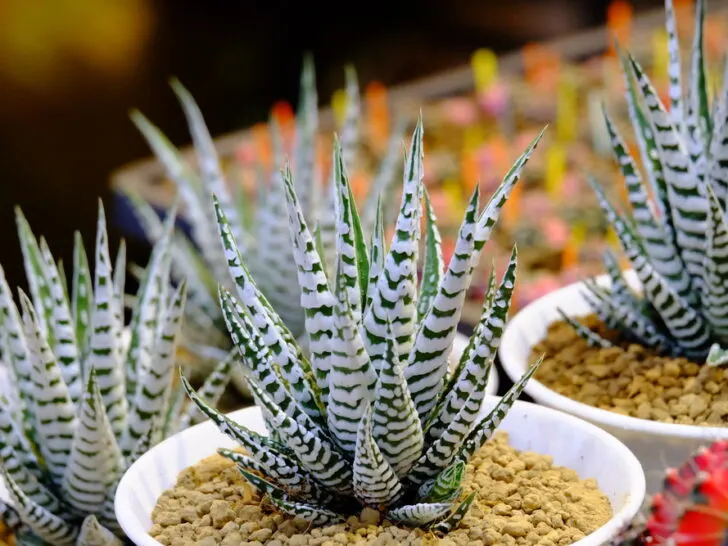
This attractive, low-growing succulent has long, slender leaves that cluster to form rosettes. It’s perfect for keeping in areas of the home that don’t receive a lot of light because, in nature, it usually lives in areas where it gets some shade.
Although your haworthia might not bloom when kept indoors, it’s still a beautiful plant to enjoy. Aim to give it about four hours of light daily, which shouldn’t be direct light.
The zebra cactus is a fantastic plant to own if you’re new to gardening because of how easy it is to maintain. Let its soil dry out before watering it, so you don’t encourage issues such as root rot that can damage or kill the plant.
7. Hoya ‘Wax Plant’
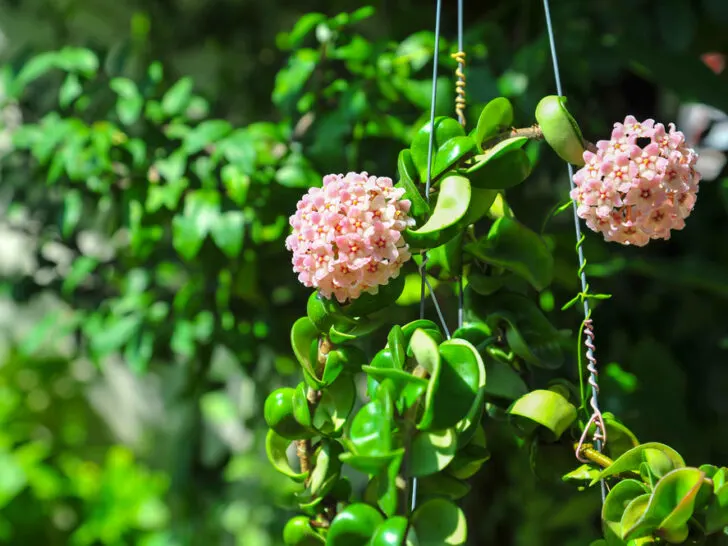
This stunning plant is known for its waxy, fragrant flowers that bloom in a variety of colors, including pink, red, yellow, and white.
These plants trail beautifully, and they reach a maximum length of up to 15 inches (38 cm). they’re ideal for small spaces and are typically grown in hanging baskets as indoor plants.
These plants don’t need direct sunlight, they do well in partial shade where they are protected from intense heat as well as frost.
8. Kalanchoe blossfeldiana ‘Flaming Katy’
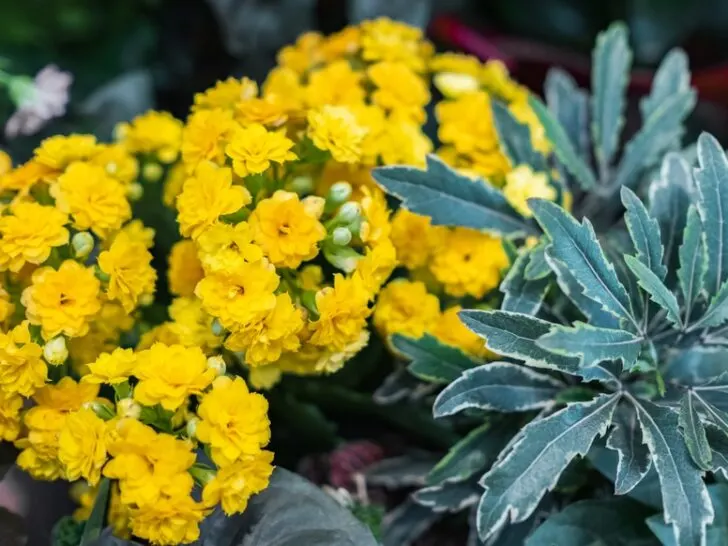
With its bright flowers and green, waxy leaves, flaming Katy will brighten up your home. Best of all, it’s easy to look after as it doesn’t require much light. If you’re keeping it outside on a patio, which you can do as long as the climate in your region is warm and sunny, ensure you bring it indoors in the winter, as a light frost is enough to kill it.
When kept indoors, flaming Katy wants at least six hours of sunlight per day. As long as you keep it on a windowsill that gets some sun, it will be enough. It can also tolerate indirect light, but make sure it’s bright.
This plant requires artificial grow lights if your home experiences long, dark, cold winter days to ensure that it blooms. Native to Madagascar, flaming Katy grows white, orange, pink, red, or yellow flowers.
9. Parodia haselbergii ‘Scarlet Ball Cactus’
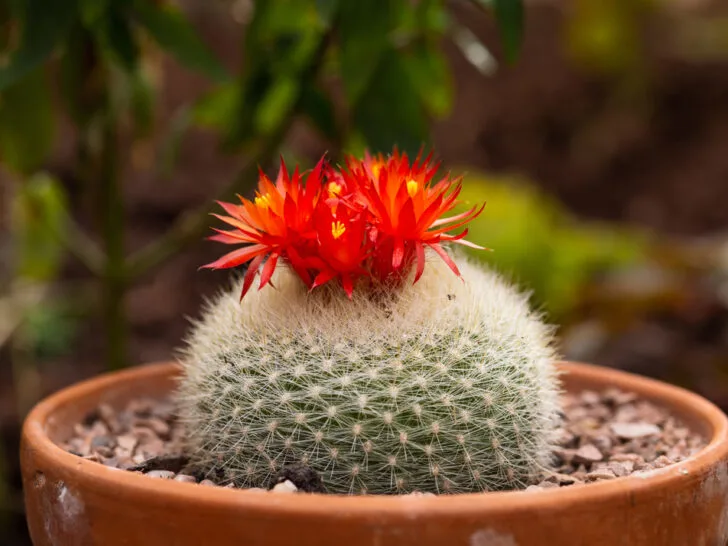
‘Scarlet Ball Cactus’ has spines covering the entire plant and bright red flowers appearing at the top of the stem. Its blooming cycle can last for a long time, which adds to its popularity. Its orange-red flowers will add lovely color to your home.
Although it might seem like this cactus is high-maintenance, it can handle full sun and partial shade. Ideally, keep it in the sunniest area of your home to encourage it to flower.
As with other indoor plants, it’s always a good idea to rotate its pot so that all parts of the plant will get enough light. Be careful when doing this with your Scarlet Ball Cactus, as its sharp spines can prick you.
10. Rebutia ‘Crown Cactus’
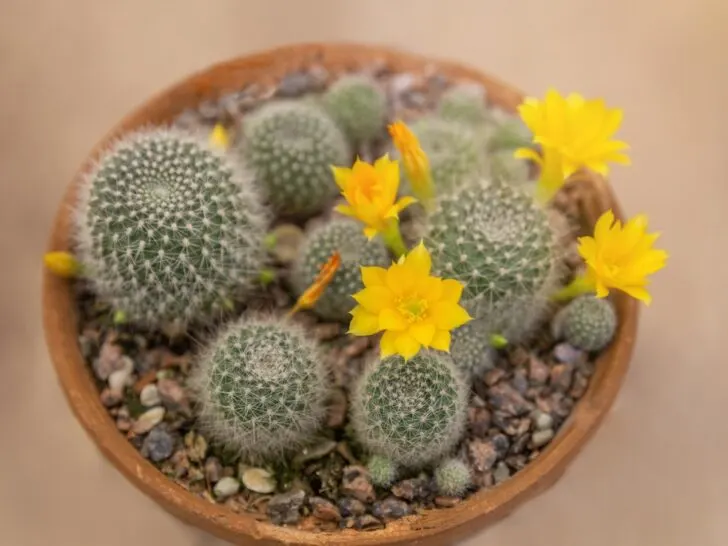
This low-light cactus is a genus of clustering cacti that are easy to look after. Native to the mountainous regions of South America, rebutia wants to be in bright light, but many species perform well in partial-shade conditions.
Make sure your home isn’t too warm, as rebutia doesn’t like to be in hot conditions, so consider this when finding a spot for it in the house.
To ensure that it thrives, feed it a succulent potting mix enriched with organic matter.
11. Rhipsalis baccifera ‘Mistletoe Cactus’
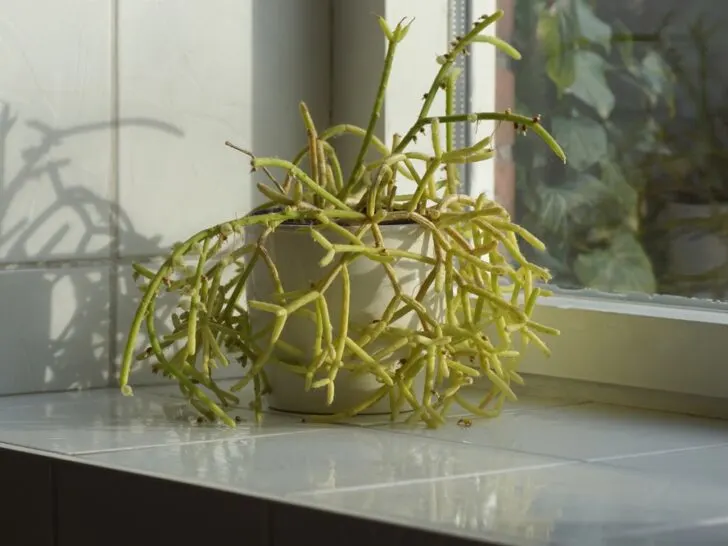
If you love succulents that grow in a trail, you’ll love the ‘Mistletoe Cactus.’ This low-light cactus can grow up to six feet (1.8 m) in height and spreads up to two feet (0.6 m). It’s a tropical epiphytic plant that grows on tree branches in forests, so it loves to draw moisture from its surroundings.
Although tropical, ‘Mistletoe Cactus’ doesn’t need lots of light. It tolerates partial-shade conditions, so don’t worry if your home doesn’t receive a lot of sunlight daily. However, note that it might struggle to grow if you don’t give it light. Keep it in bright, indirect light if possible. To achieve this, you might have to move it around to different areas in the home.
12. Sansevieria trifasciata ‘Snake Plant’
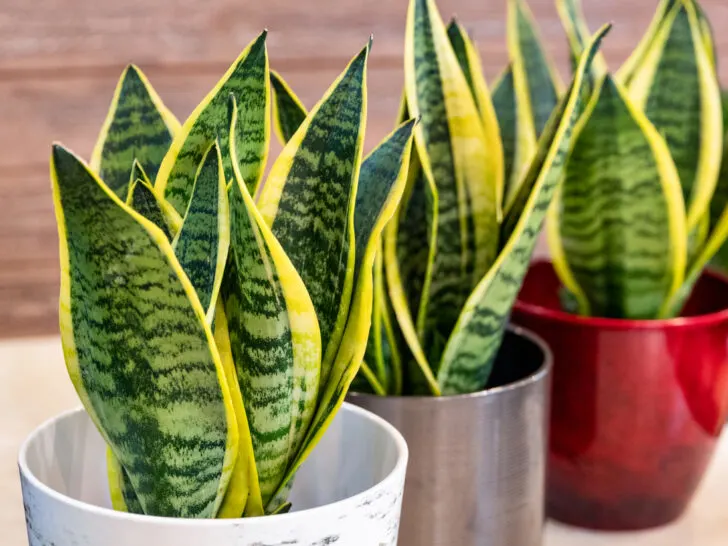
If you’re looking for low-maintenance succulents, the snake plant is one of the best. It has rigid, sword-shaped leaves that are mottled to look a bit like snakeskin patterns. It’s certainly a striking plant!
Snake plants are versatile when it comes to their light requirements. They can tolerate lots of sun or hardly any – if you have a room in the home where the light is usually dim, that’s a great spot for your snake plant. Ideally, though, these plants want indirect, consistent light so that their colors don’t fade.
Be mindful this plant can be toxic for dogs and cats. According to ASPCA it contains a compound called saponins that can cause nausea, vomiting and diarrhea if ingested.
13. Schlumbergera ‘Holiday Cactus’

Also known as the ‘Christmas Cactus,’ this plant has bright-green leaves with serrated edges and overflows its containers with tubular flowers that are in bold colors like red or purple. You should never put it in an area of the home that gets lots of direct sunlight, as this will bleach the plant’s leaves.
If your plant isn’t blooming, this is an indication that it’s getting too much light. So, move it into a room with bright but indirect light, such as a bathroom.
When repotting your ‘Holiday Cactus,’ you should place it in a shady spot in the home or patio for about two days so that it will get used to its new pot. Putting it in too much sun will damage its pretty leaves.
14. Senecio Rowleyanus ‘String of Pearls’
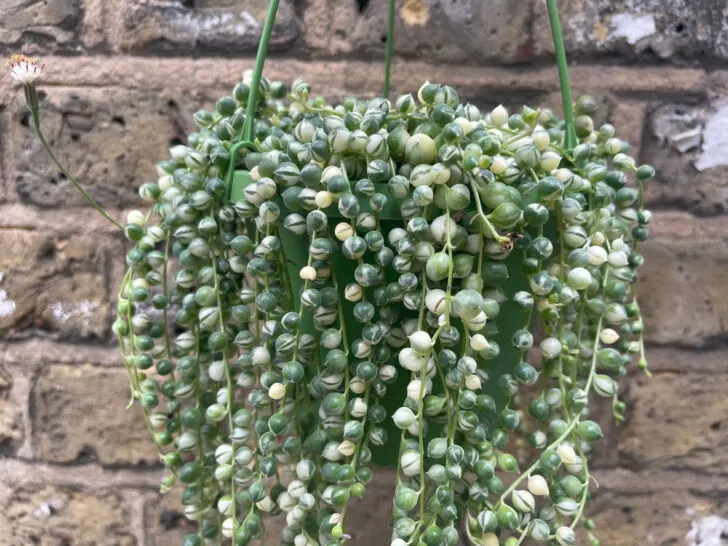
String of Pearls, is a beautiful and unique succulent made up of small, round leaves that resemble pearls, and it forms long, trailing stems that can grow up to 3 feet long.
These plants can be hung in a bright window or placed on a shelf where they can receive bright, indirect light. They can also do well in areas where they receive artificial light only.
String of Pearls are not only a beautiful addition to any indoor space, they are also incredibly low-maintenance and easy to care for.
They require minimal watering, are tolerant to a wide range of temperatures and fairly resistant to many pests. That being said, if they do get aphids or mealybugs they’re tough to shake!
15. Zamioculcas zamiifolia ‘ZZ Plant’

This low-light succulent has green, shiny leaves that are arranged in a rosette pattern, making it an attractive addition to any room. The ZZ Plant can grow up to 2 feet tall, making it a great choice for larger spaces.
Avoid direct sunlight for this plant as it can cause the leaves to turn yellow or fade. This plant prefers bright indirect light, such as a bathroom or a room with a north-facing window.
When repotting a ZZ Plant, it’s important to let the plant acclimate to its new pot before putting it in a bright location. After repotting, place the plant in a shady spot for two or three days before gradually increasing the amount of light it receives.
ZZ plants like to dry out completely before being watered, in low-light conditions this can mean it only needs watering once a month. When the top inch of soil is dry, it’s time to water your ZZ plant.
Low-Light Succulent FAQs
You’ll want to place your succulent in a location that receives some indirect or filtered sunlight. If you can, place them by an East facing window where they can soak up the sunlight for at least three to four hours a day.
Make sure you water your succulent sparingly, allowing the soil to dry out completely between waterings. You’ll want soil that is well-draining and not waterlogged to avoid root rot.
Remember to inspect these guys regularly for any signs of pests or disease, and promptly address any issues to ensure your succulent continues to thrive.
It may be ok for a short period but a succulent won’t survive long-term in a room with no light.
If you have limited or no natural light in your living space, you could buy a tabletop grow light that will give your succulent the light it needs.
A light-depraved succulent will literally start “reaching”(etiolation) out toward the light source. This sometimes gives the illusion that your succulent is growing, but it isn’t. You’ll notice when this happens, the leaves will be smaller than normal and they lose their intensity in color.
If you notice this happening, relocate your succulent closer to the light, making sure to introduce it to the light gradually.
Wrapping Up
These low-light succulents are particularly well-suited for those who may not have access to a lot of natural light in their living or work spaces.
With their unique and attractive shapes, colors, and textures, low-light succulents are a great way to bring a touch of nature into your indoor spaces.
Whether you display them in a beautiful pot, hanging basket or arrange them on a windowsill, these plants are sure to make a statement in any room.

